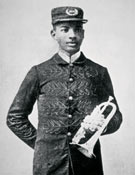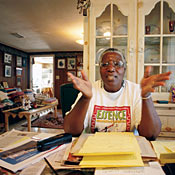BRIDGEMAN ART LIBRARY MACDUFF EVERTON / CORBIS
“History changes things,” says author Cornelia Walker Bailey, (
above) who lives on Sapelo Island, Georgia. Her surname started out as Bilali, the given name of her ancestor Bilali Mohammed. Trained as a Muslim prayer leader in his native Guinea, he was enslaved in 1803 and brought to Sapelo Island, where a small community of his descendants still lives. Bailey grew up saying Christian prayers facing east, the direction of Makkah—the same direction in which her Muslim ancestor prayed.
Above Left : W. C. Handy, “Father of the Blues” and a son of former slaves, recorded a 1903 encounter with a man playing an instrument that was evolving from an African zither into an American slide guitar.
Written by Jonathan Curiel
ylviane Diouf knows her audience might be skeptical, so to demonstrate the connec- tion between Muslim traditions and American blues music, she’ll play two recordings: The
athaan, the Muslim call to prayer that’s heard from minarets around the world, and “Levee Camp Holler,” an early type of blues song that first sprang up in the Mississippi Delta more than 100 years ago.
“Levee Camp Holler” is no ordinary song. It’s the product of ex-slaves who worked moving earth all day in post-Civil War America. The version that Diouf uses in presentations has lyrics that, like the call to prayer, speak about a glorious God. But it’s the song’s melody and note changes that closely resemble oneof Islam’s best-known refrains. Like the call to prayer, “Levee Camp Holler” emphasizes words that seem to quiver and shake in the reciter’s vocal chords. Dramatic changes in musical scales punctuate both “Levee Camp Holler” and the adhan. A nasal intonation is evident in both.
ALAN LOMAX COLLECTION / SMITHSONIAN INSTITUTION / "PRISON SONGS", VOL. 1, TRACK 11, ROUNDER RECORDS
“I did a talk a few years ago at Harvard where I played those two things, and the room absolutely exploded in clapping, because [the connection] was obvious,” says Diouf, an author and scholar who is also a researcher at New York’s Schomburg Center for Research in Black Culture. “People were saying, ‘Wow. That’s really audible. It’s really there.’” It’s really there thanks to all the Muslim slaves from West Africa who were taken by force to the United States for three centuries, from the 1600’s to the mid-1800’s
. Upward of 30 percent of the African slaves in the United States were Muslim, and an untold number of them spoke and wrote Arabic, historians say now. Despite being pressured by slave owners to adopt Christianity and give up their old ways, many of these slaves continued to practice their religion and customs, or otherwise melded traditions from Africa into their new environment in the antebellum South. Forced to do menial, backbreaking work on plantations, for example, they still managed, throughout their days, to voice a belief in God and the revelation of the Qur’an. These slaves’ practices eventually evolved—decades and decades later, parallel with different singing traditions from Africa—into the shouts and hollers that begat blues music, Diouf and other historians believe.
 Pathetic
Pathetic
 The biggest standouts of the african stock in new world blacks is Brazil is pred West-Central African, hence the big butts and Aframs had a high proportion of Senegambian/Griot Africa slaves, hence, the Blues.
The biggest standouts of the african stock in new world blacks is Brazil is pred West-Central African, hence the big butts and Aframs had a high proportion of Senegambian/Griot Africa slaves, hence, the Blues.


